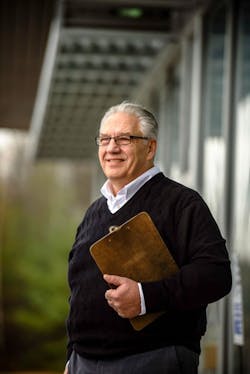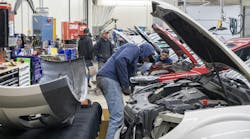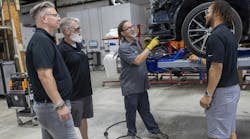Rich Altieri calls it “The Perfect Storm” of collision repair.
Altieri doesn’t say that phrase lightly, as he’s pretty much seen it all. Working his way up from car washer to shop owner to management system developer to president of Autobody Management Solutions, his 40 years of industry experience have made him a prominent voice, and a leading proponent of the lean philosophy.
While “The Perfect Storm” might sound bad, ominous, even calamitous, Altieri says it’s actually an opportunity for your shop. Because as profit potential shrinks, as insurance companies continue their stronghold over access to work, as OEM certifications make the market more competitive, as vehicle complexity increases, as the availability of qualified technicians diminishes, and as consolidation continuously shapes the industry landscape, many shops will not survive the storm—which means your business can evolve and thrive in their place.
And you can ensure that by following the Pareto principle, Altieri says.
The Pareto principle states that 20 percent of your effort is responsible for 80 percent of the finished product. And Altieri says focusing on the repair planning stages—20 percent of the repair process—is your key to surviving the storm. Because not only are repair planning mistakes the biggest creators of waste, he says, but they’re also what inevitably kill the quality, speed and performance of your finished product.
If you really are ready to fight the storm, Altieri says it starts in 2017. And to help, three industry veterans join Altieri to lay out some changes to repair planning that could make huge differences in the new year.
Pareto Principle Part 1: An Overview
Altieri says the repair planning process makes up 20 percent of a vehicle’s time at your shop, yet is responsible for 80 percent of the speed, cost and performance of your overall work—so perfecting it is key. Here are two crucial mantras for perfecting the five stages of repair planning:
Eliminate nonessential waste. Essential waste is waste that’s valuable to the business—such as parts procurement—but not the customer. Nonessential waste is important to neither the business nor the customer, and prohibits workflow. Examples include multiple supplements, finding additional damage late in the process, using damaged or wrong parts, etc.
Touch time is your most critical KPI. For too long, Altieri says the industry has focused on cycle time, which is too dependent on vehicle mix and crash severity. Touch time, however, represents the number of hours per day technicians are physically touching a car. Waste creates delays, which lead to idleness, which leads to lower touch times (the industry average is 2 hours, Altieri says, and it should be double that). Eliminating waste improves touch time, which in turn improves productivity, efficiency, cycle time—the list goes on.
Pareto Principle Part 2: Vehicle Check-In
Once the estimate has been authorized, the check-in process begins the most crucial stretch of the repair process, Altieri says. Have a consistent process in place that eliminates waste and delays:
- Wash the vehicle thoroughly to see all damage, and clean up any glass.
- Remove any personal contents so nothing gets in the technician’s way.
- Mark all unrelated damage to protect against customer claims of damage.
- Crash wrap the windows to protect the interior.
- Research OEM documentation for welding and sectioning requirements and specifications for disassembly.
- Take photos that are satisfactory to the insurance company.
On-Demand Scheduling
“The Perfect Storm” has already begun to swallow up shops—and Bob Gibson witnessed it firsthand.
“I had a friend who just sold his shop. He just got to the point where he hadn’t moved along with the industry. He hadn’t bought new equipment, hadn’t invested in training,” Gibson says. “With all the changes in the industry, he figured he’d have to flip his business upside down, so he just retired. I think there’s a lot of guys who are, unfortunately, at this point.”
Gibson, on the other hand, has been no stranger to change since taking over Total Auto Body from his father in 1989. Over the past 27 years, Gibson has focused on continuous improvement, adapting to a lean model, expanding his facility, and investing in new training and equipment for his Grafton, Wis., shop, which now pulls in just over $2 million annually with eight employees.
Gibson is also always trying to improve his repair planning process—that crucial 20 percent—and he says his biggest challenge today comes with the rising importance of OEM certifications, which he believes could replace DRPs. And with that alternative, he’s in the midst of making one huge shift that could become reality for all shops: on-demand scheduling.
The Concept
Essentially, OEMs could eliminate insurance as the middleman. And without the back-and-forth that comes with insurance companies and authorization, Gibson believes shops will need to accommodate an increasing number of walk-ins, as OEMs will automatically recommend nearby certified shops.
“With OEMs setting up networks through CCC DRIVE and phone apps, I think that the days of planning two weeks out are going to be gone,” Gibson says. “Cars are going to show up every day because you’ve networked with all these companies and gotten their certifications.”
The Technology
The “networks” Gibson is referring to are programs—such as CCC ONE, ALLDATA, Mitchell—that present OEM data to estimators by offering visual cues and prompting them when OEM information is available.
It also involves vehicle systems and apps that present a list of certified shops after an accident. OEMs partner with repair information providers and in some cases have their own apps. By utilizing these systems, Gibson brings in customers he would have previously never landed.
“We’ve had people drive their cars 100 miles to have their cars repaired here because we’re Honda certified,” Gibson says. “There’s value to it and the shops that aren’t seeing that are missing out.”
The Preparation
If you’d like to focus on OEMs over DRPs, Gibson says to chip away at your scheduled-to-walk-in ratio. Determine the number of hours your shop is capable of producing in one day—in this case, let’s say it’s 100 hours—and then reign back scheduled work. So if you’re scheduling 50 hours of work now, slowly reduce it to 20 over the next few years as you establish more OEM certifications.
The Process
Gibson has assigned one estimator to handle all walk-ins and perform the check-in, create the blueprint, and write the estimate. The estimator can then immediately communicate with the parts manager and get the vehicle onto the repair floor.
“[The estimator] can do two or three cars a day,” Gibson says. “We’re almost to the point where we need a second person.”
Pareto Principle Part 3: Mapping
Then the vehicle moves into the mapping stage, where three different colors are your guide:
- Red marks all damaged that is unrelated, not authorized and not being repaired.
- Green marks all authorized work.
- Yellow marks missed damage and any supplements.
Pareto Principle Part 4: Disassembly & Discovery
Altieri says disassembly involves the meticulous analyzing, marking, removal and storing of parts. Have a dedicated disassembly technician inspect and mark all parts to be repaired or replaced, and arrange them on a parts cart so each is clearly defined. Note any damage not included on the estimate, and any supplements to be followed up on.
Then, for the “discovery” portion, bring in the lead technician, a painter, a parts employee, and an estimator to scrutinize the job, ensure the parts listing from disassembly is correct, and plan ahead for future work.
Everyone plays a role. For example, if a color match will need to be performed, and the vehicle is in for 10 days, the painter can begin that process ahead of time. The master technician is determining whether the team has enough time to perform a unibody on a heavy hit.
The Mitchell Collision Parts Price Index (MCPPI) has been tracking collision parts trends for nine years. The latest version offers an extensive look into the most common parts replaced, the impact of foreign currency changes, and the effects of a growing OEM parts index.
Jack Rozint has over 20 years of experience in the collision repair business, offering his expertise to CCC Information Services and improving telematics systems for Bosch. And now, as Mitchell International's vice president of sales and service, he’s helping to develop Mitchell Parts, a new parts procurement solution.
As parts prices further influence the overall cost of an estimate and parts procurement systems regularly offer new options for improving efficiency, it’s important to stay ahead of parts developments, Rozint says. Here, he details four parts trends and how you can stay ahead of the curve this year.
1. Growing Parts Procurement Options
Mitchell Parts is yet another addition to the growing list of parts procurement systems available. Rozint says to never limit your shop to one system, and to instead use 2017 to evaluate your options, which include PartsTrader, CCC TRUE Parts Network, CollisionLink, Auto PartsBridge, and Car-Part. Use various systems and see which parts—whether they be OEM, aftermarket, remanufactured or recycled—offer the greatest profit margin without sacrificing quality.
“You want what’s going to work with all of your suppliers, that’s going to work for all of your estimates,” Rozint says. “Don’t use a system that your insurance company mandates. Choose one that is actually bringing operational efficiencies and benefits to you and is going to translate into increased profit and revenue.”
2. Rising Parts Inflation
Since its inception, MCPPI has tracked the relationship between parts prices and inflation, which signals changes in estimate severity and average claim estimate. Overall, this reveals the influence of parts prices on the overall cost of an estimate, which is tracked through a number representing parts inflation in the industry called the “combined total value of the index.”
“It gives you good insight into the pricing that’s most impacted by competition in any given area,” Rozint says.
The index shows a steady year-over-year overall increase, showing parts prices are rising at a higher rate than national inflation rates. And in the first half of 2016, it rose by 3.19 percent up to 137.24—more than most full-year increases over the past nine years.
"Choose [a parts procurement system] that is actually bringing operational efficiencies and benefits to you."
— Jack Rozint, vice president of sales and service, Mitchell International
3. Aftermarket Parts Rising in Prominence
Although OEM parts make up nearly 65 percent of all logged repairs, the aftermarket parts index is a full 14 points higher than OEM, offering greater profit margin potential for shop owners.
“I’ve talked to many shop owners that now say they actually prefer to use aftermarket now,” Rozint says. “The quality has gotten to the point where it’s not creating any problems with production, they’re not having to do any additional work to fit the parts, and they don’t believe there’s any actual difference in the quality of the part.”
While Gibson believes aftermarket parts could offer great profit margin potential, Gibson believes, in the long run, it’s more sensible to use OE parts.
“I give my customer a better product by purchasing what I know is a quality part,” Gibson says. “If I make $10 less in the long run, I still make out on that deal.”
4. Recycled Parts Experience Biggest Growth
The index shows a nearly 10-point rise over 2015 in recycled parts—an increase that’s higher than OEM, aftermarket and remanufactured parts. This shows that parts removed from a salvaged vehicle and remarketed through recyclers are are being recognized as a quality and cost-efficient alternative in the industry.
This may be an opportunity to diversify with your parts procurement system, Rozint says. Several parts procurement systems offer features for finding recycled parts, providing online access to a parts database with hundreds of U.S. recyclers.
While Gibson prefers OE, he believes there’s value in considering recycled parts. Aftermarket and recycled parts make up approximately 15 percent of his parts usage.
Pareto Principle Part 5: Parts Procurement
This stage is critical, as wrong parts are often the biggest timesuck and creator of nonessential waste.
To avoid trouble, take each new part out of the box and mirror match it with the old part. That way, a wrong part won’t disrupt the repair down the line. Preferably, this work is performed while the shipper is onsite, so any problems can be addressed immediately.
Then, deliver all parts to the technician performing the work, and review them once again.
Pareto Principle Part 6: Quality Verification
The most important step is where shop owners struggle the most, Altieri says—evaluation and improvement. Each successive step should be verifying the quality of the previous step, ensuring there are no hiccups. To make it easier, Altieri says to treat each step of your repair planning like its own separate company.
“So, for check-in, who is that company’s supplier? The estimator, who needs to give check-in all the necessary information to do the job,” Altieri says. “Check-in delivers the car to his customer, the mapper, and so on.
“Just like any transaction between companies, each company should expect thoroughness and accuracy, and each should hold one another accountable for doing their jobs properly. In theory, if each step is being followed according to SOPs, the best possible level of cost, speed and performance is being achieved, waste is eliminated, and touch time is high.”
Ensuring Improvement
Making tweaks to the repair planning process is one thing—guaranteeing it continues to evolve is a different (and more important) matter entirely, and it all falls back on your ability to instill a culture of continuous improvement, says Joe Carubba.
Carubba, owner of Carubba Collision, has made this a key focus over the past 27 years by establishing that culture of continuous improvement across his company. He says that culture has been key to growing his network of shops to 12 in the Buffalo, N.Y., area—and he only has more growth planned from there.
Here, he outlines the key components of guiding over 100 employees to that mindset.
Create an Onboarding Program
The first step is to ensure each new employee understands the importance of continuous improvement, Carubba says.
An employee’s first day at Carubba Collision involves an eight-hour initial orientation that offers an outline of the history of the company and outlines each department’s goals and objectives.
The next two days involve job-specific training that covers each employee’s role in the repair process. Carubba’s managers go through the SOPs that promote consistency in the process and stress the importance of eliminating mistakes during repair planning.
Establish Mini-Companies
Throughout the repair planning stages, each department follows a documented SOP that requires quality verification of the previous task.
“There is certain criteria each file and task has to meet before being handed off to the next department,” Carubba says. “We spend a lot of time on that to make sure we’re not making simple mistakes.”
Host Industry Trend Meetings
Whether it be the rise of aluminum repairs, the prevalence of autonomous vehicles, or the consolidation of the market, Carubba’s employees are well aware of the issues rapidly changing the collision repair industry.
He assures this through periodic industry trend meetings, which gather the entire company together to offer a snapshot of what the market looks like, and what changes can be expected at Carubba Collision. The 2016 meeting included information on changing vehicle technology, new I-CAR training classes, and a focus on OEM certifications.
Relay Your Goals
Regularly at individual store meetings, Carubba says his managers share the company’s overall goals with all employees so everybody is working toward a common objective.
“Whether it’s CSI scores or cycle time, we let them know how insurance companies are measuring us, how we fit in the measurements compared to our competition, and where we want to be if we’re not there already,” he says.



